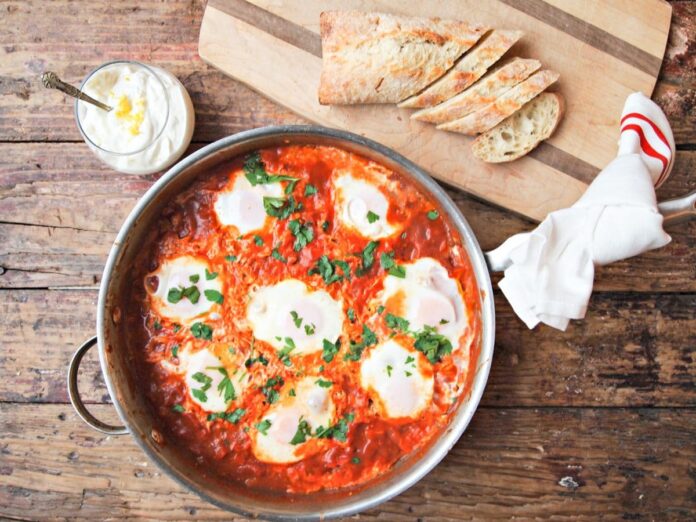
Shakshuka is easily one of the most versatile dishes ever invented. It is inexpensive,
healthy, and easy to make, not to mention that it falls right in the class of comfort foods.
If that was not enough, you can make it with ingredients likely already in your fridge and
have it for breakfast, lunch, or dinner.
And the icing on the cake? This meal is a one-pan wonder that eliminates the need for
countless dishes- and subsequent cleaning.
But what exactly is shakshuka?

Shakshuka is a famous Israeli dish consisting of a thick sauce of tomatoes, peppers,
onions, garlic, and various spices topped with poached eggs. Mostly, it is eaten with an
accompaniment of bread or other starches. Check out SpiceWorldinc.com for bread recipes.
The word shakshuka means ‘mixed up’ or ‘jumbled up,’ which is ample description of
what it is. Over the years, different methods of preparing the dish have emerged,
ranging from vegetarian to meat variations.
What are the origins of shakshuka?

While shakshuka is a staple meal in Israel, it has its origins in the Middle East and North
Africa, likely from Tunisia and Yemen. Historians, however, believe that it dates as far
back as the Ottoman Empire, where it consisted of meat and vegetables.
It is believed that this dish was taken to Israel by Jewish immigrants from North Africa
who, without much to spend, relied on it for sustenance. Gradually, as new ingredients
such as tomatoes and peppers were introduced from the west, the dish evolved, and
variations of it spread worldwide.
In Italy, for example, there is a similar dish known as ‘eggs in purgatory,’ and in Mexico,
you will find ‘huevos rancheros.’ Present-day Turkey enjoys ‘menemen’, a meal with
eggs scrambled in with tomatoes, peppers, and spices.
Because of its simplicity and use of ordinary, everyday ingredients, shakshuka has
spread its tentacles to breakfast tables all over the world. The specific ingredients might
vary with where you are, but at its heart is the comforting goodness of fresh, healthy
ingredients.
When is the best time to have shakshuka?

As mentioned, on simshomekitchen.com, this dish is so versatile that you can have it for
breakfast, lunch, or dinner. In Israel, it is found in most breakfast tables, but this is not
cast in stone.
While you can have it at any time, shakshuka is sure great for those cold, winter days
when you need something hot and spicy to warm you up. Not to mention healthy,
hearty, and comforting and a great addition to a vegetarian diet.
Might you have had a few too many at that office party? There is no better cure for a
hangover than eggs in a thick tomato sauce with plenty of veggies or meat.
If you love to host, a beautifully done shakshuka can be the perfect centerpiece in a
family dinner.
How to make shakshuka

One thing that makes this dish great is its adaptability. You can add whatever
ingredients you want, or leave those that you don’t like. For instance, if you are not that
keen on vegetarian food, you can add minced beef or sausages.
You can also add vegetables like spinach and asparagus with goat cheese or feta. You
can add a variety of spices or have it mild.
Depending on how many people you are cooking for, you can add and reduce
ingredients as you see fit. Whichever way you like it, you cannot go wrong with
shakshuka.
Here is our favorite (traditional) shakshuka recipe:
Ingredients:
● 4 tablespoons olive oil
● One onion, diced
● Four garlic cloves, diced
● One green bell pepper, chopped
● One red bell pepper, chopped
● 2 teaspoons paprika
● ½ teaspoon cumin
● 2 teaspoons sugar
● 1 teaspoon cayenne pepper (or add as needed)
● 1 800g (28 ounces) can whole peeled tomatoes
● Six large eggs
● Small bunch of coriander/ parsley/ cilantro chopped
● Salt and pepper to taste
Instructions
1. Heat the olive oil in a frying pan over medium heat. Add the onion and cook until
translucent.
2. Add peppers and continue stirring until both ingredients are soft, then add garlic
and other spices. Cook for another two or three minutes.
3. Pour the tomatoes and stir them in a mashing fashion using a large wooden
spoon. Add the sugar and continue stirring.
4. Add salt and pepper and allow it to simmer for about 15-20 minutes. Do not
skimp on the simmering time as you need the sauce to thicken enough to support
the eggs.
5. Using the large wooden spoon, create ‘wells’ in the sauce and break the eggs
into each well.
6. Turn the heat down, cover the pan and cook for a few more minutes until the
eggs are done to your preference.
7. Garnish with the cilantro/coriander/parsley and serve with your choice of bread.
The most popular options are pita, nan, or challah.
Notes:
● A typical shakshuka is prepared with runny, poached eggs. If this is the
consistency you are looking for, be careful to take them off the heat early enough
as they will continue cooking. You can also leave the pan on longer to cook them
some more.
● Although traditionally this dish is served with a side of bread, you can also have it
with couscous or rice, as well as other starches such as roast potatoes and
quinoa.
● If you are the adventurous type, do not be afraid to try different mix in ideas such
as chicken, shrimp, eggplants, or chickpeas.
● If you are having your shakshuka for breakfast, you can prepare the tomato
sauce the previous night to save time. All you have to do in the morning is add
the eggs.
● Shakshuka is not the ideal candidate for leftovers, as the eggs will continue to
cook when heated. But, if you have some leftover anyway, no reason that you
can’t re-heat it the next day and even add some new toppings.











